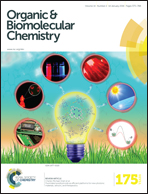Selective recognition of neutral guests in an aqueous medium by a biomimetic calix[6]cryptamide receptor†
Abstract
The design of artificial receptors that can efficiently work in water is a challenging research area. A possible biomimetic approach for the elaboration of such receptors consists of associating a hydrophobic cavity with a polar polyfunctional binding site. On this basis, a hydrophilic calix[6]cryptamide decorated with oligo(ethylene glycol) units (i.e.8) was synthesized through an efficient [1 + 1] macrocyclization reaction as the key-step. The complexation of neutral molecules was evaluated by NMR spectroscopy through competition experiments either in apolar or aqueous media. In both media, host 8 can bind neutral species that display H-bonding acceptor and donor groups such as amides or ureas. Interestingly, the most polar and acidic molecule is the best guest in chloroform and the worst one in an aqueous medium, highlighting the importance of the environment. As shown by NMR and X-ray diffraction data, the mode of recognition involves a complementary DAAAD-ADDDA quintuple H-bonding array between the binding partners as well as multiple CH–π interactions. A comparison of this calix[6]arene-based host–guest system with the binding site of biotin-binding proteins shows strong similarities. Besides, the acid–base control of the binding properties of receptor 8 in aqueous media is highly reminiscent of allosteric processes encountered in natural systems.
![Graphical abstract: Selective recognition of neutral guests in an aqueous medium by a biomimetic calix[6]cryptamide receptor](/en/Image/Get?imageInfo.ImageType=GA&imageInfo.ImageIdentifier.ManuscriptID=C5OB02067K&imageInfo.ImageIdentifier.Year=2016)

 Please wait while we load your content...
Please wait while we load your content...